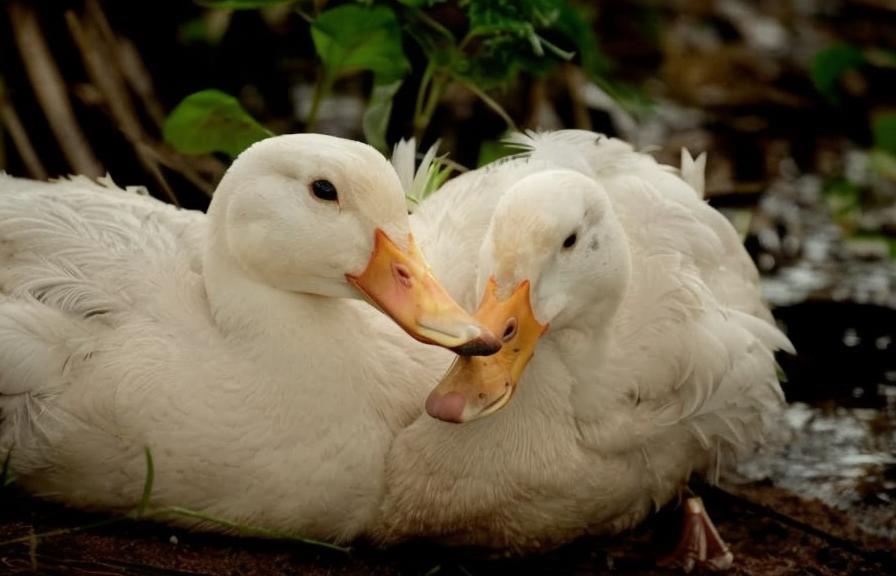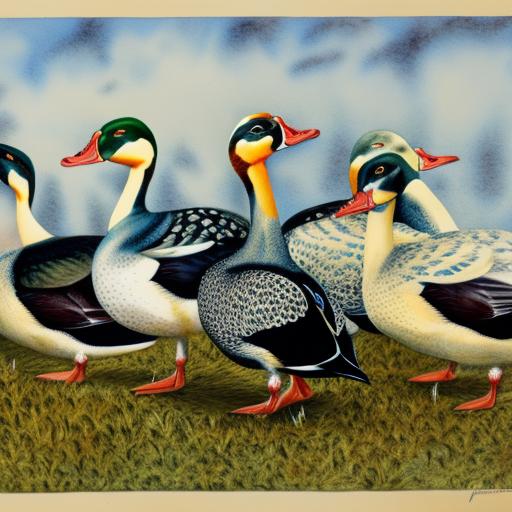Ducks are a popular choice for meat production due to their delicious, lean meat and relatively easy care. There are several breeds of ducks that are specifically bred for meat production, each with its own unique characteristics and advantages. In this article, we will explore some of the most popular duck breeds for meat, including Pekin, Muscovy, Rouen, Aylesbury, and Khaki Campbell ducks. We will discuss the key traits of each breed, their suitability for meat production, and best practices for raising them. Whether you are a small-scale farmer looking to raise ducks for your family’s consumption or a commercial producer looking to enter the duck meat market, understanding the different duck breeds and their specific qualities is essential for success.
Key Takeaways
- Pekin ducks are the most popular breed for meat production due to their fast growth rate and high meat yield.
- Muscovy ducks are known for their lean and flavorful meat, making them a popular choice for gourmet dishes.
- Rouen ducks are a heritage breed with a large body size and excellent meat quality, making them a favorite for traditional duck dishes.
- Aylesbury ducks are prized for their tender and succulent meat, making them a popular choice for roasting.
- Khaki Campbell ducks are known for their high egg production and good meat quality, making them a versatile choice for meat and egg production.
- Best practices for raising meat ducks include providing a balanced diet, ample space for exercise, and proper housing to ensure their health and well-being.
Pekin Ducks
Pekin ducks are one of the most popular duck breeds for meat production. They are known for their fast growth rate, efficient feed conversion, and large breast muscles, making them an ideal choice for meat production. Pekin ducks have a white plumage and orange bills and feet, making them easily recognizable. They are also known for their calm and friendly temperament, which makes them easy to handle and manage. Pekin ducks are excellent foragers and can thrive in a variety of environments, making them a versatile choice for meat production. Their meat is tender and flavorful, with a good meat-to-bone ratio, making them a favorite among consumers. Pekin ducks are also known for their high egg production, making them a dual-purpose breed suitable for both meat and egg production.
Pekin ducks are relatively low-maintenance and can adapt well to different management systems. They thrive in free-range systems where they have access to natural forage and water sources, but they can also be raised in confinement with proper housing and management. When raising Pekin ducks for meat production, it is important to provide them with a balanced diet that meets their nutritional needs for optimal growth and development. Additionally, proper housing, ventilation, and biosecurity measures should be in place to ensure the health and well-being of the ducks. Overall, Pekin ducks are an excellent choice for meat production due to their fast growth rate, efficient feed conversion, and high-quality meat.
Muscovy Ducks
Muscovy ducks are another popular choice for meat production due to their lean and flavorful meat. Unlike other duck breeds, Muscovy ducks have distinct characteristics such as a red facial caruncle and a unique appearance. They are known for their quiet and docile nature, making them easy to handle and manage. Muscovy ducks are excellent foragers and can thrive in free-range systems where they have access to natural forage and water sources. They are also known for their strong flying ability, which allows them to roost in trees and escape from predators. Muscovy ducks have a slower growth rate compared to other duck breeds, but they make up for it with their high-quality meat and efficient feed conversion.
When raising Muscovy ducks for meat production, it is important to provide them with a balanced diet that meets their nutritional needs for optimal growth and development. Proper housing and management are also essential to ensure the health and well-being of the ducks. Muscovy ducks are known for their excellent maternal instincts and can be used for natural hatching and brooding of ducklings. This makes them a valuable asset for small-scale farmers looking to raise ducks for meat production. Overall, Muscovy ducks are an excellent choice for meat production due to their lean and flavorful meat, strong flying ability, and natural hatching and brooding instincts.
Rouen Ducks
Rouen ducks are a popular choice for meat production due to their large size and excellent meat quality. They are similar in appearance to Mallard ducks but are larger in size with a distinctive color pattern. Rouen ducks have a calm and friendly temperament, making them easy to handle and manage. They are also known for their excellent foraging ability and can thrive in free-range systems where they have access to natural forage and water sources. Rouen ducks have a slower growth rate compared to Pekin ducks but make up for it with their large size and flavorful meat.
When raising Rouen ducks for meat production, it is important to provide them with a balanced diet that meets their nutritional needs for optimal growth and development. Proper housing, ventilation, and biosecurity measures should also be in place to ensure the health and well-being of the ducks. Rouen ducks are known for their high meat-to-bone ratio, making them an excellent choice for meat production. Their flavorful meat is prized by consumers and is often used in gourmet dishes. Overall, Rouen ducks are an excellent choice for meat production due to their large size, excellent meat quality, and strong foraging ability.
Aylesbury Ducks
Aylesbury ducks are a traditional English breed known for their white plumage and large size. They are a popular choice for meat production due to their tender and succulent meat. Aylesbury ducks have a calm and friendly temperament, making them easy to handle and manage. They are also known for their efficient feed conversion and can thrive in a variety of management systems. Aylesbury ducks have a slower growth rate compared to Pekin ducks but make up for it with their large size and flavorful meat.
When raising Aylesbury ducks for meat production, it is important to provide them with a balanced diet that meets their nutritional needs for optimal growth and development. Proper housing, ventilation, and biosecurity measures should also be in place to ensure the health and well-being of the ducks. Aylesbury ducks are known for their tender and succulent meat, making them a favorite among consumers. Their white plumage also makes them an attractive choice for marketing purposes. Overall, Aylesbury ducks are an excellent choice for meat production due to their large size, tender meat, and attractive appearance.
Khaki Campbell Ducks

Khaki Campbell ducks are a popular choice for both egg and meat production due to their high egg production and lean meat. They have a khaki-colored plumage with a slender build, making them easily recognizable. Khaki Campbell ducks are known for their excellent egg-laying ability, making them a dual-purpose breed suitable for both egg and meat production. They have a calm and friendly temperament, making them easy to handle and manage.
When raising Khaki Campbell ducks for meat production, it is important to provide them with a balanced diet that meets their nutritional needs for optimal growth and development. Proper housing, ventilation, and biosecurity measures should also be in place to ensure the health and well-being of the ducks. Khaki Campbell ducks have a leaner meat compared to other duck breeds but make up for it with their high egg production. Their flavorful meat is prized by consumers and is often used in gourmet dishes. Overall, Khaki Campbell ducks are an excellent choice for meat production due to their high egg production, lean meat, and calm temperament.
Best Practices for Raising Meat Ducks
When raising ducks for meat production, there are several best practices that should be followed to ensure the health and well-being of the ducks as well as the quality of the meat produced. Providing proper housing that protects the ducks from predators and extreme weather conditions is essential. Ducks should have access to clean water for drinking and bathing as well as ample space to exercise and exhibit natural behaviors.
A balanced diet that meets the nutritional needs of the ducks is crucial for optimal growth and development. Ducks should be provided with access to natural forage as well as commercial feed that is formulated specifically for meat production. Proper ventilation in the housing facilities is important to maintain air quality and prevent respiratory issues in the ducks.
Biosecurity measures should be implemented to prevent the spread of diseases among the duck flock. This includes regular cleaning and disinfection of housing facilities, limiting visitors to the farm, and quarantining new birds before introducing them to the existing flock.
Regular health checks by a veterinarian or experienced poultry keeper can help identify any potential issues early on and prevent the spread of diseases within the flock.
In conclusion, raising ducks for meat production can be a rewarding endeavor when done with proper care and management practices in place. Understanding the specific traits of different duck breeds can help producers make informed decisions about which breed is best suited for their production goals. By following best practices in housing, nutrition, biosecurity, and health management, producers can ensure the health and well-being of their duck flock as well as the quality of the meat produced.
When it comes to raising ducks for meat, choosing the right breed is crucial. In a recent article on PoultryWizard, they discuss the best duck breeds for meat production, providing valuable insights for poultry farmers and enthusiasts. If you’re interested in exploring other poultry options, PoultryWizard also offers informative articles on topics such as “Can Guinea Fowl Live with Chickens?” and innovative coop designs like the “SnapLock Chicken Coop.” Check out their website for more expert advice on poultry care and management. (source)
FAQs
What are the best duck breeds for meat production?
The best duck breeds for meat production include the Pekin, the Muscovy, and the Rouen. These breeds are known for their fast growth, high meat yield, and good feed conversion rates.
What is the Pekin duck breed known for?
The Pekin duck breed is known for its fast growth, high meat yield, and excellent feed conversion rates. It is one of the most popular duck breeds for meat production due to its white feathers, which make processing easier.
What are the characteristics of the Muscovy duck breed for meat production?
The Muscovy duck breed is known for its lean and flavorful meat. It has a higher percentage of breast meat compared to other duck breeds and is also known for its ability to forage for food, reducing feed costs.
What are the advantages of raising Rouen ducks for meat?
Rouen ducks are known for their large size and excellent meat quality. They are also good foragers, which can help reduce feed costs. Additionally, Rouen ducks are known for their calm and docile temperament, making them easier to handle.
What should I consider when choosing a duck breed for meat production?
When choosing a duck breed for meat production, consider factors such as growth rate, meat yield, feed conversion rates, foraging ability, and temperament. It’s also important to consider your specific production goals and the resources available for raising ducks.
Meet Walter, the feathered-friend fanatic of Florida! Nestled in the sunshine state, Walter struts through life with his feathered companions, clucking his way to happiness. With a coop that’s fancier than a five-star hotel, he’s the Don Juan of the chicken world. When he’s not teaching his hens to do the cha-cha, you’ll find him in a heated debate with his prized rooster, Sir Clucks-a-Lot. Walter’s poultry passion is no yolk; he’s the sunny-side-up guy you never knew you needed in your flock of friends!







